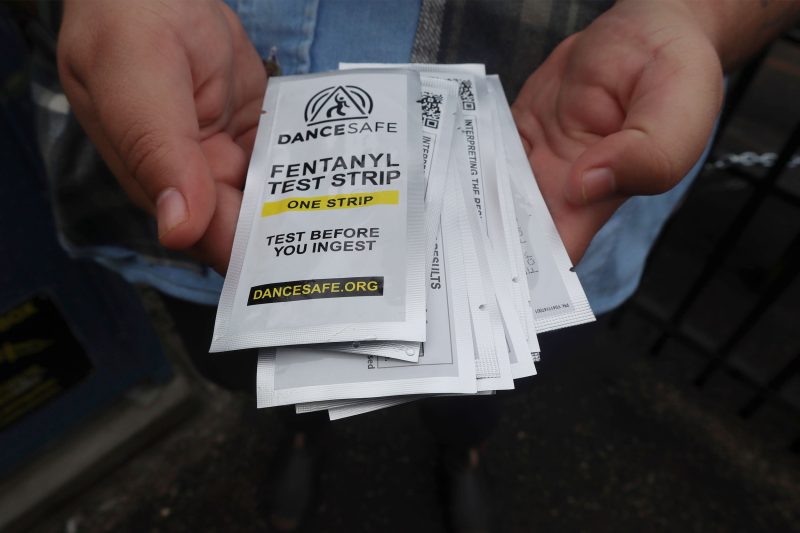The Massachusetts state Senate voted unanimously to legalize fentanyl test strips across the commonwealth earlier this month. The paper indicators had been considered illegal drug paraphernalia as they could be used to test whether the highly powerful, dangerous synthetic opioid was present in a sample. Many street drugs have been found to contain fentanyl, which has become a leading cause of overdose death.
The inexpensive strips have been embraced by treatment organizations as a way to reduce harms from illicit drug use. Nearly 40 states have legalized their use, according to the Network for Public Health Law. The Gazette spoke with Sarah Wakeman, the senior medical director for Substance Use Disorder at Mass General Brigham about the legal shift over use of the products. This conversation has been edited for length and clarity.
What are fentanyl test strips and how are they used?
A test consists of a little white rectangle that you dip into a liquid substance that contains a drug, and it will test for whether fentanyl is present or not. You lay it flat, and — like a pregnancy test or like a COVID test — after two to five minutes, it will show results.
They’re important because we live in an era of contaminated drug supply. The illicit drugs (meaning those that people buy outside of a pharmacy or from an unregulated source) have become incredibly contaminated. For example, substances that were formerly sold as heroin in Massachusetts are almost entirely illicitly manufactured fentanyl.
But the contamination is also happening with other drugs. Someone may be buying what they think is cocaine or a benzodiazepine pill, but there could be small amounts of fentanyl present. That is incredibly risky and puts them at great risk of overdose.
Why is there so much contamination?
It’s a tough thing to study, but as best as we can tell, it’s most likely unintentional. First, it’s important to know that fentanyl is tremendously potent. Even a small amount of fentanyl, especially for someone who’s not used to using opioids, could cause an overdose.
93%
of overdose deaths in Massachusetts in 2022 included fentanyl
Imagine someone who is selling drugs. They may be selling cocaine and also selling opioids or fentanyl. If they’re doing that in their home, it’s not like being in a regulated laboratory where pharmaceutical drugs are being made, packaged, and distributed. Even a little bit can get cross-contaminated if you’re using the same surface to cut, bag, or weigh a substance. That’s likely the source of contamination.
There’s a lot of urban legend out there about the intentional contamination of drugs, but that doesn’t really make any sense. It makes no sense to put your customer at risk of dying. I think the reason that myth perpetuates is that there’s a lot of stigma and stereotype when we think about the people who are selling or using drugs.
It is the primary driver of overdose mortality in Massachusetts and across the nation. In Massachusetts, fentanyl was present in 93 percent of the opioid-related overdose deaths in 2022. And of those, cocaine was also present in 53 percent.
Are we seeing a lot of deaths due to fentanyl in Massachusetts?
When we look at people who are dying with multiple substances present, the vast majority of the time they also have fentanyl present. It’s hard to know if they were intentionally using multiple substances simultaneously or if it was an unintentional exposure.
Why do the strips make sense as a public policy response?
People who use drugs don’t want to die. And people who use drugs have not forfeited their human rights, including the right to life and health. Most people in the U.S. use drugs, whether it’s caffeine, alcohol, or nicotine.
Let’s use alcohol as an example. We have a regulated supply system. When you use alcohol, you know when you’re ordering a glass of wine, a beer, or a cocktail. You know roughly what the alcohol by volume content is, and you can make choices around how much you’re going to consume and the impact it’ll have on your body.
But think back to Prohibition, when alcohol was illegal. We saw a ton of alcohol-related harm: People were going blind from contamination in the alcohol supply, we saw people dying from alcohol poisoning. That wasn’t because new people were using alcohol or people were using more alcohol suddenly; it was because the supply was unpredictable, unregulated, and poisonous.
Right now, we exist in an era where the illicit drug supply in this country is unregulated, contaminated, and often poisonous. One way to keep people safe is to give them knowledge of what it is that they’re using. Fentanyl test strips are not a panacea, but they are a way for someone to know if fentanyl is present or not.
“Even a small amount of fentanyl, especially for someone who’s not used to using opioids, could cause an overdose.”
Sarah Wakeman
What are some of the limitations?
Well, because we have this unregulated supply, the end user is basically powerless over the drug supply. They are at the mercy of what’s happening in the supply chain and supply-side pressures on the market, and there’s been this shift from lower-potency heroin to essentially all illicitly manufactured fentanyl. If you’re using opioids in Massachusetts, you’re almost certainly using fentanyl.
So it becomes less helpful to know, “Is fentanyl present in this thing that I’m using?” Because the answer will most likely be yes. In those cases, there’s more advanced drug-checking techniques that you could use that give a more detailed breakdown of what’s present in the substance, but those are much harder to disseminate widely, and they’re very expensive. So those would be kind of the two main limitations: One is that everything’s fentanyl right now, and two is that the testing strips don’t actually provide a breakdown of how much fentanyl is present or what else is in the drug supply.
With fentanyl test strips, one clear barrier to their usage was obviously their legality. But what about their availability?
I think the more available, the better. Thankfully, despite the fact that technically, fentanyl test strips have been illegal, they have been relatively available through harm-reduction organizations and substance-use-disorder treatment organizations. It’s been a great resource to be able to offer those to people and to start a conversation about understanding contamination and the risks of unintentional overdose.
My hope is the test strips could become even more available so that someone could go to a drugstore, pharmacy, or convenience store and be able to purchase them. We want multiple touchpoints and multiple avenues for people to be able to empower themselves and stay safe.
One criticism of making fentanyl test strips available is that it might encourage drug use. This is a criticism of harm-reduction strategies in general. Is that a problem?
This has long been a fear that if you give people tools to make something safer, they’re going to take greater risk. But we actually have really good evidence in the drug-use space that harm reduction interventions don’t encourage drug use.
We’ve seen that with naloxone [used to treat overdose] and naloxone distribution. Naloxone saves lives. Counties that have greater access to naloxone have lower rates of overdose death, and that’s been shown here in Massachusetts. Although I’m not aware of rigorous studies of fentanyl test strips reducing overdoses, I think we have a really robust portfolio of evidence from harm reduction interventions — and broader public health harm reduction interventions — that demonstrate their potential to save lives.
How does stigma fit into this conversation?
There are so many stereotypes that deeply impact the way our society thinks about drug use and people who use stigmatized drugs, in particular those from marginalized communities. These stereotypes portray people who use drugs as unreliable, dangerous, deceitful, and pleasure-seeking. And none of that’s true. And yet those myths and stereotypes continue to drive our policies, our clinical models, the way the public thinks about drug use.
If we look at communities of people who use drugs, stereotypes have resulted in a lack of support from society at large. So people have taken care of each other. Communities of people who use drugs have risen up to figure out pragmatic solutions to save the lives of their neighbors, community members, people they care about. The fact that naloxone programs have been so effective proves this. Harm reduction at its core is about radical love and acceptance for another human being. And yet as a concept, it’s gotten attached to these misperceptions.





